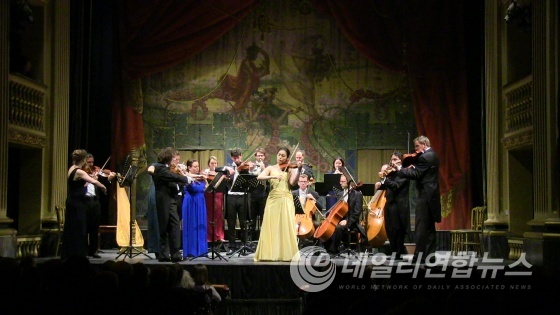바이올리니스트 박민하, 몰타의 International Spring Orchestar Festival
오프닝 무대로 음악의 중심에 서다.
이탈리아의 시칠리아섬에서 남쪽으로 약 93킬로미터 떨어져있고, 대한민국의 강화도 만한 작은 나라인 몰타. 하지만 지중해의 한가운데에 위치한 이 아름다운 곳에서는 올해 10주년을 맞이한 International Spring Orchestra Festival이 4월의 시작을 알렸다. 천혜의 자연환경 속에 더할 나위 없는 깊은 음악적 영감으로 가득한 축제의 현장이 된 몰타의 수도 발레타에는 관광객 뿐 만 아니라 수 많은 음악인들과 국가적으로도 큰 행사인 만큼 관련된 귀빈들과 현장의 생생함을 영상으로 남기기 위한 방송인들의 발길로 가득 차 있었다. 4월 1일부터 9일까지 과거와 현재를 아우르는 다양한 레퍼토리의 음악이 펼쳐지는 이 페스티벌의 오프닝 콘서트에 지난 4월 1일 바이올리니스트 박민하가 Euro Union Chamber Orchestra와의 협연으로 그 서막을 알렸다.

무대가 어두워지고, 화려한 무대 사이로 바이올리니스트 박민하가 등장했다. 모차르트가 1775년 그가 태어났던 잘츠부르크에서 작곡하여 1775년 12월 20일에 완성된 곡 Violin Concerto No. 5 in A Major, K. 219 “터키협주곡” 의 선율이 오케스트라 단원들 사이로 흐르기 시작했다. 1악장은 마치 무도회를 보는 듯 색다르게 서있는 오케스트라 단원들 사이에서 그녀는 춤을 추듯 자연스러운 몸짓 사이로 경쾌하면서도 밝은 바이올린 선율을 빚어내기 시작했다. 모차르트 특유의 멜로디 선율을 바이올리니스트 박민하는 마치 지중해에 비치는 태양을 가득 품은 바다처럼 광대하면서도 하나하나 반짝이는 물결처럼 그려내었다. 그리고 이어진 2악장, 서정적이면서 느린 멜로디의 흐름 사이로 그녀의 어린 나이를 무색하게 할 만큼의 여유로운 표정과 선율은 고스란히 관객들에게 전달되었다. 마지막 3악장에서는 초반에 우아한 미뉴에트의 느낌이 시작되다가 중반 부분의 터키풍의 운율은 그녀의 음악적인 힘 조절의 최대치를 보여주기에 매우 적합했다. 물리적인 힘이 아닌 현과 활 사이 어떠한 스침과 힘이 들어가야 하는지에 대한 치밀한 계산은 이미 그녀의 음악적 감정 속에 숨겨졌지만 깊이 베어 들어 느낄 수 없을 만큼의 자연스러운 선율을 만들어 내었다. 가장 과학적이고도 가장 감성적인 힘을 가진 것이 음악이 아닌가 라는 자문을 하게 만드는 순간이었다. 약 27분 정도에 걸친 그녀의 연주가 끝나면서 관객들은 아직 어리고 더 나아가야 할 세상이 훨씬 많음에도 불구하고 이미 지중해와도 같은 그녀의 폭넓은 연주력과 감정에 감탄한 듯 끊임없는 박수로 화답했다.
오늘 그녀의 연주를 보며, 필자는 솔리스트로서의 돋보임과 오케스트라와의 어울림, 그리고 과학적이면서도 감성 사이를 넘나들어야 하는 음악인들의 숙제가 쉽지 않겠다라는 생각을 순간 잊어버리게 되었다. 물론 그렇지 않을 것이라는 것을 짐작해왔고, 또 짐작한다. 모든 세상의 일들이 그렇겠지만 조금 더 그 경계 최전선에 있는 음악. 끊임없이 음악이 가진 상반된 특징들을 모두 안고 가야 하는 음악인들이 때로는 존경스럽기까지 했다. 다만 그 어린 나이에도 그녀가 품고 쏟아내는 연주는 이미 그 끝없는 숙제를 짐이라 생각하지 않고, 자연처럼, 호흡처럼 늘 안고 살아가는 당연한 것처럼 보이게 만든 것이 같은 한국인으로서 자랑스럽고 그 미래까지도 기대하게 만들었다. 앞으로 숨겨진 많은 노력들 사이로 흐를 그녀의 선율은 더 넓고도 많은 관객들의 삶에 깊이 베어들 것 같다.
@예술통신_쉔부른(글쓴이. 비엔나에서 이한나)
Violinist Minha Park plays the “Turkish” concerto
Violinist Minha Park knows how to shine on stage; like the glimmering ocean reflecting the sun. Performing Wolfgang Amadeus Mozart’s one of successive violin concertos, Violin Concerto No. 5 in A Major, K. 219 (also known as the “Turkish” Concerto), Park has managed to play the composition like an upbeat opera piece. Even with small sized orchestra, named the European Union Chamber Orchestra, led by Hans-Peter Hoffmann, as a conductor and first violin; the stage was filled with melodic and deep sounds. The audience enjoyed the light-hearted music, as the artists playfully fulfilled their roles as orchestra and soloists.
The dramatic scope of the Concerto No. 5 is truly impressive: it is very nearly an opera in concerto guise, with the soloist as protagonist. Mozart no longer asks the soloist to be content merely to slip into the first movement after the orchestra has made the requisite exposition of the main material, but instead actually stops the Allegro aperto movement altogether at the point of the solo violin entry and provides a wonderfully rich six-measure Adagio. The Allegro aperto almost immediately begins anew, but the fact that the solo violin had the power to halt the entire ensemble at so unlikely a juncture remains fresh in the mind throughout the rest of the concerto -- and it is worth noting that even as that Allegro aperto opening music takes off again, the violinist supplies a completely new melody, a high-flying, electrifying one, to go along with it.
The Adagio is a superb movement, longer by a considerable span than the slow movements of the previous four concertos. The melody tumbles along sublimely, and in the central portion we are treated to one of the most astoundingly beautiful passages ever conceived.
Mozart turns again to the French Rondo finale that he used in the third and fourth violin concertos for his third movement (Tempo di menuetto). In a French Rondo, the basic movement is interrupted in mid-stride by a section that contrasts with it in every way, and it is from this contrasting section -- a wild, frenzied Allegro -- that the "Turkish" Concerto gets its nickname.
@예술통신_Schönbrunn(Written in Vienna by Rebecca L.)























